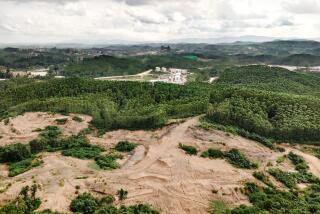In Aceh, stranded ships a reminder of the 2004 tsunami
BANDA ACEH, INDONESIA — They are the ships that fell from the sky; two immovable objects, their very presence defying reason.
Residents call them acts of God. Most cannot fathom that the two ocean vessels were transported miles inland by floodwaters of the 2004 tsunami that ravaged this small city on Sumatra’s northern tip.
Miles apart, both have been left intact as memorials to the 170,000 residents of Aceh province who either died or disappeared in the disaster.
Five years after the waters rose to biblical heights, the city continues to rebuild, constructing schools, clinics, roads and villages in coastal areas that had been wiped clean by the invading ocean.
“Acehnese people have moved on with their lives. Most of them have returned to their homes,” said Yusriadi, a tourism office spokesman who goes by one name. “Aceh is back to normal.”
Not for everyone. Some say Banda Aceh is forever changed, harboring a newfound respect for the natural forces that surround it. Dotting the city are boats of all shapes and sizes that rode the rush of water far from their ocean habitat.
None elicit more amazement than the two behemoths.
One is revered as “Noah’s Ark,” a 100-foot wooden boat that crashed on top of a house, providing a refuge for 59 terrified people who say they would have died without its shelter.
The other is stranger still -- a colossal vessel weighing 2,600 tons that plopped down two miles inland, like Dorothy’s Kansas farmhouse crash-landing in Oz.
It’s also a graveyard: Neighbors say a dozen bodies from the tsunami may still languish beneath the ship.
One tourist from Jakarta, the Indonesian capital, snapped photographs of the iron vessel, called the Apung, which he said was a warning that man cannot always undo what God and nature have accomplished.
“Who among us could ever move this big ship?” said Sugiono, who also goes by one name. “God can bring it here from the sea, but we just don’t have the ability to bring it back.”
The tsunami cut a swath around the Indian Ocean, devastating coastal towns and villages in Indonesia, Thailand, Sri Lanka and elsewhere.
Triggered by a massive deep-sea earthquake 80 miles off the coast of Banda Aceh, the wall of water hit at 8 a.m. on Dec. 26, 2004, leaving death and wreckage in its wake.
One survivor who runs a market in the shadow of the larger ship lost his 5-year-old daughter in the panic.
Bustamam, 45, was at home with family when the earthquake hit. Within moments, he heard the cries from neighbors.
“The water is coming! The water is coming!” they shouted.
“We were all running in fear when the first wave came,” he recalled. “I was holding my 5-year-old as tightly as I could. But my head was hit by a piece of wood.
“I don’t remember what happened next. But when I came to my senses, my little girl was gone.”
His wife, Ani Maulani, said she and their other two children were swept to the roof of a house 300 feet away.
When the tsunami subsided, she took a breath to consider her new surroundings. And there it was, towering 60 feet above the poor, low-lying neighborhood.
“At first, I thought it was some big house,” she recalled while sitting in her market, resting her bare feet on a case of bottled water. “I didn’t think it was a ship. I thought, ‘How could it be?’ ”
The Apung, a power-generating ship owned by the local electrical company, had crashed down atop two houses, killing the inhabitants.
Now it’s one of Banda Aceh’s biggest tourist attractions. Passing souvenir shops, visitors climb a series of metal gangplanks to the top of the craft, covered with red-and-white Indonesian flags and advertisements for shampoo and cigarettes.
One cloudy afternoon, Bustamam boarded the ship. Standing by a blue air duct dotted with graffiti, he pointed to the sea.
“Over there,” he said of the boat. “That’s where it came from.”
His wife said she has no intention of ever boarding the monster: There are just too many memories.
“I know it will give me a heart attack and make me think of my lost daughter,” she said. “I’m already sad enough.”
Several miles away, in another tsunami-stricken neighborhood, officials left the so-called Noah’s Ark ship in its new landlocked mooring out of a sense of reverence.
The wooden boat now resembles a discarded children’s toy, cocked at an angle atop a forlorn house.
On a recent morning, workers scraped and painted the ship’s exterior, a refurbishment project leading up to the upcoming fifth anniversary ceremony.
Next door, sitting on a porch cradling her grandson, Basyariah Nurdin recalled the day the boat dropped down on Banda Aceh. She and her neighbors were running from the flood, taking shelter on the second floor of a house. But soon the waters rose to their necks, she said.
Suddenly, they heard a sound “like thunder.” Moments later, fearing they were about to drown, they broke through the ceiling in an effort to reach the safety of the roof.
Instead of finding daylight, they found a boat.
“We stayed there for seven hours, until the waters went down,” Nurdin said. “It really was Noah’s Ark. I don’t think we would be here today if it weren’t for that boat.”
--
More to Read
Sign up for Essential California
The most important California stories and recommendations in your inbox every morning.
You may occasionally receive promotional content from the Los Angeles Times.











